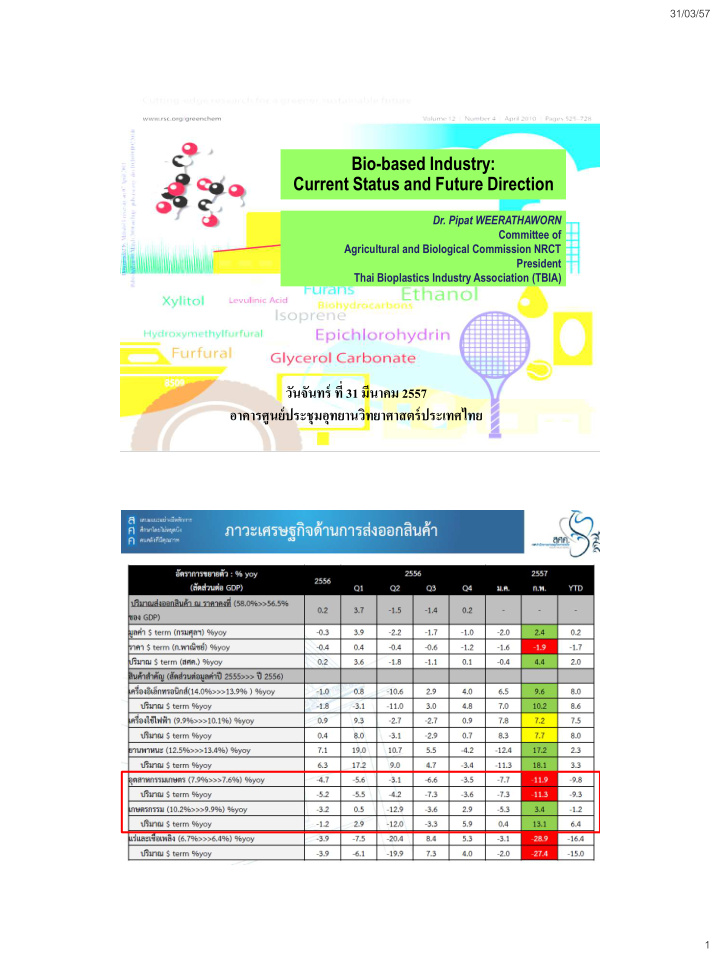



31/03/57 Bio-based Industry: Current Status and Future Direction Dr. Pipat WEERATHAWORN Committee of Agricultural and Biological Commission NRCT President Thai Bioplastics Industry Association (TBIA) วันจันทร์ ที่ 31 มีนาคม 2557 อาคารศูนย์ประชุมอุทยานวิทยาศาสตร์ประเทศไทย 1 1
31/03/57 US Bioeconomy Plan The National Bioeconomy Blueprint Five strategic objectives for a bioeconomy 1. Support R&D investments that will provide the foundation for the future U.S. bioeconomy. 2. Facilitate the transition of bio inventions from research lab to market, including an increased focus on translational and regulatory sciences. 3. Develop and reform regulations to reduce barriers , increase the speed and predictability of regulatory processes, and reduce costs while protecting human and environmental health. 4. Update training programs and align academic institution incentives with student training for national workforce needs. 5. Identify and support opportunities for the development of public- private partnerships and precompetitive collaborations — where competitors pool resources, knowledge, and expertise to learn from successes and failures. EU Bioeconomy Plan Innovating for Sustainable Growth: A Bio-economy for Europe A BIOECONOMY STRATEGY FOR EUROPE EUROPEAN COMMISSION Brussels, 2012 The Europe 2020 Strategy calls for a bio-economy as a key element for smart and green growth in Europe. Advancements in bio-economy research and innovation uptake will allow Europe to improve the management of its renewable biological resources and to open new and diversified markets in food and bio-based products. THE BIOECONOMY ACTION PLAN 1. Investments in research, innovation and skills 2. Reinforced policy interaction and stakeholder engagement 3. Enhancement of markets and competitiveness in bio-economy The Bio-economy Strategy and its Action Plan aim to pave the way to a more innovative, resource efficient and competitive society that reconciles food security with the sustainable use of renewable resources for industrial purposes, while ensuring environmental protection. 2
31/03/57 3
31/03/57 Sugarcane Composition U.S. Department of Energy, 2004 Bio-based Value Chain 4
31/03/57 Opportunity for Bio-based Chemicals Share of biobased chemicals will grow significantly. Biobased commod. Biobased Biobased 4% commod. commod. 0.07% 1% Biobased Biobased Biobased specialty specialty specialty 0.36% 7% 12% Biobased fine Biobased fine Fossil 1.09% Fossil 98.46% Biobased 2% 89% polymer Biobased Biobased fine Fossil 0.02% polymer 5% 75% 1% Biobased polymer 4% 2005 2010 2025 $ 1200 billion total $ 1400 billion total $ 2200 billion total 1.7% biobased 9-13% biobased 22-28% biobased How to balance those usages? Source: EFIB 2010 Thailand's opportunity in Green Economy Corn Stover Bagasse 1 Cassava Corn Grains Sugarcane Sugarbeet 1 st generation (230) (822) (1,110) (1,740) (230) 2 nd generation Ethanol/ Biopolymers Starch Ferment with Sugar/ Yeast Sucrose Many feedstock alternatives possible for today’s green products. Renewable resources are “any natural resources that are capable of being regenerated or replaced by ecological processes on a time scale relevant to their use ”. 1 By product from sugar production 10 SOURCE: IEA; USDA FAS; SRI; press; Foreign Agricultural Service/USDA Office of Global Analysis; US Grain Council; World Agricultural Outlook Board; Statistics Canada 5
31/03/57 Source: Unica 2012 Leading Players in Biobased Chemical 3-HPA PE/PP Succinic 1,3-PDO Bio-based acid PBS Products Starch, Lactic acid Veg Oil PHA 6
31/03/57 Leading Players in Biobased Chemical Policy and Direction • What is Thai market’s position? • Where is the market? • What should be the bio-products? • What do we have to develop? – Technology – Personal Competency – Synergy 7
31/03/57 THAILAND “ BIO-INDUSTRIAL HUB in ASIA ” • Bio-Energy • Bio-based Chemicals • Bio-Plastics • Bio-Medicals 15 Thank you! Questions & Answers Dr. Pipat Weerathaworn E-mail: pipat.we@pttgcgroup.com 081 819 8654 8
Recommend
More recommend